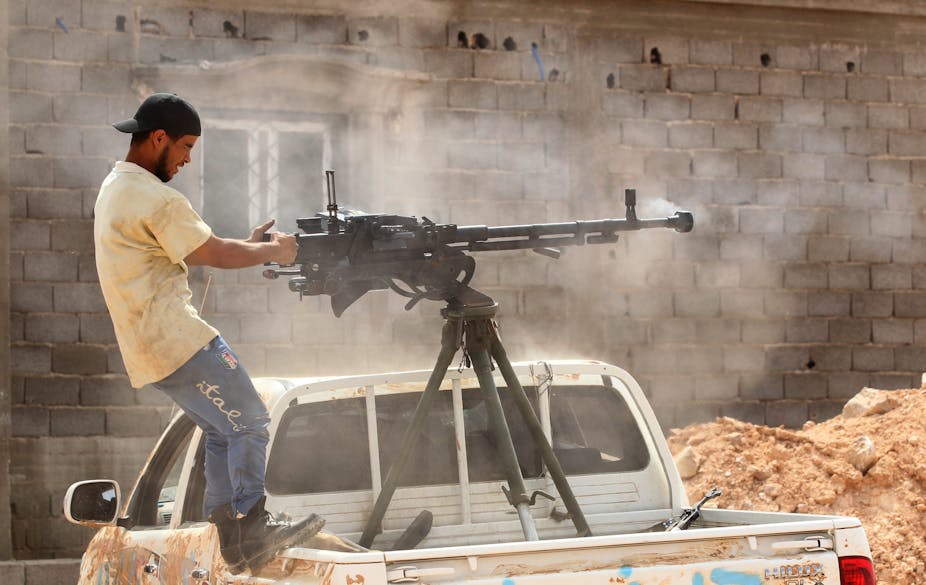Somewhere in the bowels of Toyota City there must be a cadre of marketing salarymen working out how the corporation can apply for official sponsorship of the Libyan Revolution.
After all, the whole ground campaign seems to have been made possible by their Hilux and Landcruiser utes, so why not get some mileage out of it?
Alternatively, might we see a fashionable new range of the vehicles pitched here? Complete with home-sprayed camouflage and quad-barrelled anti-aircraft guns?
DIY armoured corps
Yes, when it comes to mobile African warfare, nothing beats the jury-rigged vehicle known as the “technical”.
Tanks are usually owned by the government and use too much juice anyway. Ditto aircraft and heavy artillery.
So instead, every rebel commander knows that all you’ve got to do is grab a civilian commercial vehicle, strap on some military hardware, pile the back up with volunteers in assorted states of uniform and speed off to the front line.
Etymology of the gun truck
The technical gets its name from a euphemism back in the days of the Somalia relief rort.
Media crews, NGOs and other civilian types had to pay for the security services provided by local warlords. Little more than a bare-faced protection racket, the fees for these mercenary services were often noted down as “technical assistance”.
The goons were sometimes paid just to pose menacingly on their 4WDs behind the network news stars doing a live cross.
The popularity of these improvised military vehicles in African warfare is due to their more peaceful prevalence within the freelance transport economy.
Every marketplace, bus station and industrial zone in the continent is packed with the same plain vanilla Japanese models. Their owners strive to eke every last dinar out of them by hauling passengers, freight, livestock, agricultural produce … just about anything that needs to be moved from A to B.
Everything that can possibly be packed into the bed and the cab will be, until the point where the axles are just about scraping the road. The driver’s offsider, with his trademark fistful of grubby notes, will negotiate the price and perhaps decide who gets the privilege of riding up front. For an extra fee, of course.
Sometimes whole extended families will pool years of savings to buy their pick-up because of the steady stream of income it can provide.
Small wonder then that when it comes to irregular warfare, the irregular freight fleet is at the front line.
History re-invents itself
It’s fitting in a way that the Libyan desert is now host to so many technicals because it’s where the idea began. In the improvisational days of 1941, the British Army in North Africa was willing to give just about anything a go.
Talented amateurs with a knack for infiltrating their own chains of command were able to get all sort of experiments approved. Mixing old school connections, a vast and fluid campaign theatre and a large dose of balls-out bravado, groups such as the SAS, Long Range Desert Group and Popski’s Private Army made liberal use of unarmoured trucks and jeeps with all manner of weaponry bolted on.
Pushing deep into the Sahara, they were able to outflank the more hidebound Axis forces on scouting missions, raids and liaison missions deep into Libya, Tunisia and Algeria. It is said that the SAS ground attacks on airfields destroyed more enemy aircraft in North Africa than did the RAF.
Sturdy, reliable and cheap
Post-war, it’s probably no coincidence that the Soviets managed to produce heavy weaponry that fits perfectly in the bed of a pick-up or is easily towed behind.
A practical people used to peasant technical mash-ups, the anti-aircraft cannons and recoiless rifles they sent around the world by the millions were easily adapted to African circumstances.
Of course firing a multi-barrelled cannon from the bed of a light vehicle with a civilian suspension is not a recipe for great accuracy.
But then a lot of the firing in the Libyan campaign is more about keeping the enemy’s head down and your own morale up whilst you wait for the Eurofighters to drop their loads.
And you need to be comfortable whilst doing it. In my favourite snippet of technical footage from Libya, I noted a plump, balding gent sitting in the gunner’s seat of some piece of nasty-looking Soviet hardware.
As he leaned forward to look through the sights I noted that he had carefully draped his backrest with the therapeutic goodness of a wooden beaded seat cover.
If it’s good enough for a cabbie, it’s good enough for a revolution.

